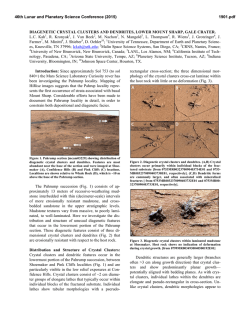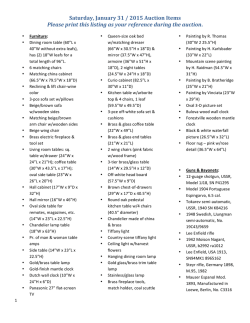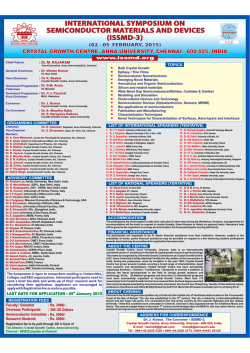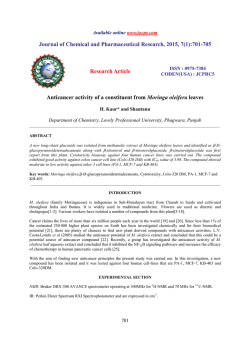
Computerized Determination of Growth Kinetic Curves and
ANALYTICALBIOCHEMISTRY 187,262-267 (1990) Computerized Determination of Growth Kinetic Curves and Doubling Times from Cells in Microculture Herta Reile, Institut fiir Received July Herbert Pharmazie, BirnbGck, Giinther Sonderforschungsbereich Bernhardt, 234, Universittit Sprul3, and Helmut Regensburg, D-8400 Regensburg, Schgnenberger Federal Republic of Germany l&l989 In this paper we describe the microcomputer-aided determination of cell proliferation kinetics and doubling times utilizing a crystal violet assay and a 3-(4,5-dimethylthiazol-2-yl)-2,5-diphenyl-2H-tetrazolium bromide assay in microtitration plates. The analysis of spectrophotometric data provides the doubling times at any time of incubation. Plots of doubling time versus time of incubation give reproducible information on the exact duration of the logarithmic growth phase. This method is applicable to anchorage-dependent as well as anchorage-independent cells when calorimetric or fluorometric data are accessible. o isso Academic press, h. A great problem in the testing of new anticancer drugs by the cell culture technique is the marked genetic instability of tumor cells (1,2) entailing an extreme clonal variation (3). This becomes evident with growing numbers of passagesfrom a permanent change of parameters of cell proliferation like the duration of the lag phase and of the log period, the doubling time, and the saturation density (plateau level). For example, Reddel et al. (4) observed such a perpetual decrease of doubling time in subcultures of the human breast cancer cell line T-47-D. Since drugs can show quite different inhibitory effects dependent of the growth parameters of a given tumor cell line, the knowledge of the growth parameters in each test series is of importance for the experimental reproducibility. Although it is generally postulated that the exposure of the tumor cells to the drug should occur in the phase of exponential growth, this demand often does not meet experimental verification. Conventionally, mean doubling times are determined graphically from the mid log phase or calculated from initial and final cell numbers (5) counted with either a hemocytometer or an electronic particle counter which requires removing the cells from their substratum. Either method could lead to severe misinterpretation due 262 Thilo to practical difficulties in distinguishing the lag phase from the phase of exponential growth. In this publication we describe a microcomputer technique which allows the registration of growth curves of cells in monolayer cultures by large scale spectrophotometric measurement after crystal violet staining’ (6) or MTT incorporation (7-9) using 96-well microtitration plates. This method enables the overall growth curve especially the lag phase and the log period to be determined in a more exact way. As a consequence it is also possible to precisely assessthe doubling time (TAU) at any time of the experiment. In our opinion a plot of TAU versus time (t) provides the maximum information available from cell proliferation experiments. METHODS Chemicals. Reagents (A-grade purity) were obtained from Merck. Crystal violet and MTT were purchased from Serva; dimethyl sulfoxide (DMSO) spectrophotometric grade was obtained from Aldrich. Millipore-filtered water was used throughout. Cell lines and culture conditions. MDA-MB-231 (ATCC No. HTB 26), a human adenocarcinoma of the breast, was maintained in McCoy’s 5A medium (Boehringer) containing L-glutamine, NaHCO, (2.3 g/liter), gentamycin (50 mg/liter), and 10% NCS (GIBCO) in 75 cm2 flasks (Falcon Plastics 3023) as a monolayer. The cells were serially passagedweekly following trypsinization using trypsin/EDTA (Boehringer). P388DI (ATCC No. CCL 46), a murine lymphoid neoplasm, was grown in a suspension culture in Dulbecco’s modified Eagle’s medium (Seromed) containing glucose ’ Abbreviations used: crystal violet, N-hexamethylpararosaniline; MTT, 3-(4,5-dimethylthiazol-2-yl)-2,5-diphenyl-2~-tetrazolium mide; DMSO, dimethyl sulfoxide; PBS, phosphate-buffered OD, optical density; PC, personal computer; NCS, newborn rum. brosaline; calf se- 0003-2697/90 $3.00 Copyright 0 1990 by Academic Press, Inc. All rights of reproduction in any form reserved. COMPUTERIZED I DETERMINATION Cell Ii&e: MDA-MB-231 cnItum conditions: MCCOY’S + 10% NCS humidlfkd atmosphere. 37O (96% air. 5% coa 1 of cells In at defined C 96well density Incubation Fixation of cells with 1% glutaraldehyde in PBS for 15 min. after varying times of incubation. Storage under PBS at 4O C Staining of 0.02% of cells crystal Extraction with with violet a solution (30 min.) of bound 70% ethanol GROWTH KINETIC 263 CURVES (I) MDA-MB-231 cells were processed as shown in Flow Chart 1 by modifying the crystal violet staining procedure described by Gillies et al. (6). (II) The proliferation of P388D1 cells was quantitated according to a microculture modification of the tetrazolium assay (7-9, 11): MTT was prepared as a 1 mg/ml stock solution in medium and filtered through a 0.22-pm filter to remove undissolved dye. At the times indicated in Fig. 1, 50 ~1 of stock MTT solution was added to all wells, each containing 100 ~1 of cell suspension. The plates were gently shaken and incubated at 37°C for another 1.5 h. Supernatant removal was accomplished by carefully inverting and blotting the tray; no prior centrifugation was needed, since the macrophage-like cells sedimented and adhered to the substratum. One hundred microliters of DMSO was added to all wells to dissolve the formazan crystals. Cytogenetic analysis. The cells were grown to about 50% confluence on microscopic slides. The slides were prepared as described elsewhere (12). So that spindle I 1 Plating nicmplates OF MAIN stain MENU J I 1 Measurement of optical (EL 309 Autoreader. density BIOTEK) I Computer-aided data analysis DATA FLOW violet dye sensitivity CHART 1. Registration procedure. Optical and reliability. density of growth reading curves at 578 using nm gives the T O FILE crystal improved (4.5 g/liter), NaHCO, (3.7 g/liter), sodium pyruvate (110 mg/liter), gentamycin (50 mg/liter), and 10% horse serum (Boehringer) in 75cm2 culture flasks. The cells were passaged every 3-4 days by 1:40 dilution with fresh medium. Both cell lines were grown at 37°C in a humidified atmosphere of 95% air and 5% carbon dioxide. Mycoplasma contamination was monitored by routine assay techniques (Hoechst 33.258) (lo), and only mycoplasma-free cultures were used. Registration of growth curves. The assay was carried out in flat-bottomed microtitration trays (Falcon Plastics 3075). Optical density was read using a Biotek EL 309 Autoreader (Tecnomara) at 578 nm (crystal violet) and 540 nm (MTT). POLYNOMIAL LEAST SQUARES FLOW CHART FIT 2. Analysis of spectrophotometric data. 264 REILE ET AL. 60 1.5 50 0 0 ,0 0 0” 10 B aloo 0 0 0 60 120 180 " 60 TINE [hrs] FIG. 1. (A) Calorimetric measurement of growth in were unknown, numbered upon receipt from the ATCC) MTT was added to all wells, and after another 1.5 h the cell line MDA-MB-231 was plated in the 38th passage medium/well and were allowed to attach. Cell densities microscope (320X). At the times indicated, the cells were end of the experiment all trays were stained with crystal at 578 nm. (B) Plots of the corresponding doubling times, = C Uiti; (i = 0, 1, . . . , n) Ui This polynomial = regression 180 microtitration plates. (0) P388D1 leukemia cells from passage 28 (original passage seeded at a density of 8 X 10’ cells/ml (Coulter Counter ZsI). At the times indicated, plates were developed and read immediately at 540 nm. (@) The human breast cancer from origin at a density of 12 cells per field of vision. The cells were seeded in 100 ~1 were estimated by counting 50 fields of vision using a Leitz Diavert phase-contrast fixed with 1% glutaraldehyde in PBS for 15 min and stored under PBS at 4°C. At the violet simultaneously. OD was measured after extraction of the dye with 70% ethanol calculated from the data shown in A, versus time of incubation. formation could be inhibited, the slide chambers were inoculated with Colcemid solution (Serva) to a final concentration of 0.04 pg/ml and incubated for 3 h at 37°C. The medium was removed by suction and replaced with 0.075 M KCl. After 30 min of incubation at 37°C an equal volume of cold, freshly made fixative (absolute methanol/glacial acetic acid, 3/l) was added. This hypotonic/ fixative mixture was removed immediately and replaced twice with ice-cold, fresh fixative. The slides were removed from the dish and air-dried. The chromosomes were stained for 8 min with 10 ml Giemsa plus 90 ml of 0.025 M KH,PO,, pH 6.8. Computer processing. Readings from the EL 309 autoreader (Biotek) were transferred directly to an Olivetti M24 personal computer, using a program that saved the OD values on a diskette. The program for data processing is graphed in Flow Chart 2. Doubling time analysis. Curve fitting of experimental data is accomplished by a polynomial regression fit applying the least-squares method. Optical density is described as a function of time and data points are fitted to an nth order polynomial (usually n = 5) represented by OD = f(t) 120 TIME [hrs] coefficients. is defined in the time interval of points observed. Once the polynomial fit has been performed the doubling time TAU can easily be calculated at any time of the interval concerned provided that exponential growth is observed (13), TAU = l/cu a! = l/in(2) .d ln(OD)/dt OD = C aiti, and hence TAU = ln(2).(C Uit”)/(C i*oit”-‘); (i = 0, 1, . . . , n). ABS (TAU) is plotted versus time. From this plot the time interval where exponential growth occurs and the corresponding doubling time can easily be determined. The software for evaluating cell kinetic data was developed in FORTRAN and PASCAL and implemented on an Olivetti M24 pc. RESULTS Figure 1 illustrates the growth curves and the corresponding doubling times at any time of incubation for an anchorage-dependent (MDA-MB-231) cell line and an anchorage-independent (P388D,) cell line. The curves were registered using two different staining tech- COMPUTERIZED # 100 DETERMINATION , l 80 T 5 60 * 7 P 3 J x 40 20 0 0 60 120 180 TINE [hrs] FIG. 2. Reproducibility of doubling time determination by the crystal violet assay. MDA-MB-231 cells were plated at an approximate density of 15 cells per field of vision (Leitz Diavert, 320X). The calculated doubling times from four different experiments (all processed separately) are plotted versus time of incubation. niques: crystal violet for MDA-MB-231 and MTT for P388D1. Due to their macrophage-like properties (tendency to attach) no centrifugation step was required in the case of P388DI cells. A general application of the MTT procedure to anchorage-independent cells requires a centrifuge equipped with a rotor capable of accepting multiplates. Under the given experimental conditions for both cell lines the logarithmic phase covers only a small fraction of the overall growth curve. In a plot, doubling time (TAU) versus time of incubation (t) (Fig. lB), exponential growth is characterized by a parallelism of the graphs with the t-axis. Although in Fig. 1A the time points are not equidistant the calculated doubling times for the exponential growth phase are not significantly affected by closely spaced points at either end of the curve. A close scattering of data at both ends is required to separate the log phase from the lag and the plateau phases where cell proliferation becomes extremely slow resulting in infinite doubling times. Therefore only quantification of the log phase is of biological significance. MDA-MB-231 grows exponentially for about two generations with a doubling time of -34 h, whereas the log phase for P388DI at the given plating density is restricted to one doubling of the population. By performing the doubling time calculations from four successive crystal violet processing procedures utilizing MDA-MB-231 cells in the same passage seeded at comparable plating densities, we encountered an interassay variation of ~13% (Fig. 2). OF GROWTH KINETIC 265 CURVES The karyotype information presented in Fig. 3 gives an example for the dramatic variability of a well-defined cell line after prolonged culture in vitro following cryopreservation. Genotypic changes do not only reflect phenotypic characteristics like morphology, but may also alter cell physiology as well as cell proliferation, which directly affects doubling time (14). Figure 4 illustrates the alterations in doubling time as a result of the number of passages. The doubling times of MDA-MB-231 cells maintained under constant culture conditions decreased constantly with prolonged time in culture. In the crystal violet assay the cells were seeded at comparable densities. The doubling times vary enormously over a wide range from x10 h for a late (85th) to =38 h for a relatively early (35th) passage. The variation most probably arises from the selection of faster growing subclones from an initially heterogeneous population by frequent and incomplete trypsinization of the culture. It is widely accepted that the initial cell number influences the proliferation kinetics of eukaryotic cells. This marked influence on doubling time is shown in Fig. 5. DISCUSSION While a variety of techniques (6-10, 15) including an enzyme immunoassay for estimating small cell numbers (16) have been described recently for the determination of parameters for cell proliferation, little interest was focused on the construction and analysis of growth curves in animal cell culture. / 25 / I I / 80 90 100 / n 2ot II 50 60 70 110 185 CHROMISOME NUMBER FIG. 3. from origin, in passage rethawed. metaphase Genetic instability of MDA-MB-231 cells. (Cl) 27th passage (H) 35th passage from origin: The cells were cryopreserved 28 for about 6 months and then passaged weekly, when For each passage the chromsomes from 50 well-spread plates were counted. 266 REILE It has been common practice to assume that cells exhibit ideal exponential growth regardless of the diversities of experimental designs without further verification. In our opinion the description of the overall growth characteristics with an exact determination of the lag/ log phases, the doubling time (TAU), and the plateau level is absolutely necessary. In addition to the characterization of cell lines (e.g., morphology, karyotype, receptor pattern, sensitivity to antitumor drugs) the description of the exponential growth phase is a prerequisite for any valuable experimental setup. Especially, the investigation of cell lines underlying extreme genetic variability, e.g., transformed cells and cancer cells, requires a precise description and verification of the parameters concerned. Due to time-consuming and difficult experimental procedures this is usually not performed. The major disadvantage of the methods described so far (5, 17, 18) is the production of mean values rather than exact values. Due to laborious working techniques only a few data points are generally obtained. This results in poor graphical estimates which make the separation of the lag/log/plateau phases of growth curves extremely difficult and unsatisfactory. In this paper we describe a technique which offers a number of advantages compared with conventional methods. This inexpensive, rapid, and technically easy microtitration assay gives access to large sets of data thus providing results of high statistical significance. The equipment necessary (microplate reader, PC) is available in almost every analytical laboratory today. loo- 80 - ET AL. l I I 60 120 TIK 180 [hrs] FIG. 5. Doubling time as a function of initial cell number. MDAMB-231 cells were plated in passage 39 at different densities: (0) 10, (A) 16, and (m) 36 cells per field of vision (Leitz Diavert, 320X). Because of the mathematical representation of the data an exact determination of the log period is guaranteed. TAU as a function of time clearly reveals the duration of the lag and plateau phases. This approach overcomes the major drawback of graphical methods which only give a poor estimate of cell kinetics. This method offers universal applicability to biological investigations whenever growth kinetics must be monitored. Its use is by no way restricted to calorimetric measurement. Its application can also be extended to turbidimetric, fluorometric, radiochemical, etc., monitoring techniques. The only prerequisite is that a large number of data which can be digitized are available. ACKNOWLEDGMENTS This work was supported by the Deutsche Forschungsgemeinschaft and the “Matthias Lackas-Stiftung fiir Krebsforschung.” Thanks are also due to the Fonds der Chemischen Industrie for financial support. The helpful assistance of F. Birk in solving data transfer problems is gratefully acknowledged. 60 - REFERENCES 1. Whang-Peng, J., Lee, E. C., Kao-Shan, Lippman, M. (1983) J. Natl. Cancer Inst. 2. Yunis, J. J. (1983) Science 221,227-236. 0 60 120 TIE FIG. 180 [hrs] 4. Doubling time as a function of passage using MDA-MB-231 cells in the (0) 35th, (0) 39th, and (0, n ) 85th passage. (m) The cells were plated at double density (ca. 30 cells per field of vision, Leitz Diavert, 320X). C.-S., Seibert, 71,687-695. K., and 3. Seibert, K., Shafie, S. M., Triche, T. J., Whang-Peng, J. J., O’Brien, S. J., Toney, J. H., Huff, K. K., and Lippman, M. E. (1983) Cancer Res. 43,2223-2239. 4. Reddel, R. R., Alexander, I. E., Koga, M., Shine, J., and Sutherland, R. L. (1988) Cancer Res. 48,4340-4347. 5. Reddel, R. R., Murphy, L. C., Hall, R. E., and Sutherland, R. L. (1985) Cancer Res. 46,1525-1531. COMPUTERIZED 6. Gillies, R. J., Didier, N., and Denton, DETERMINATION M. (1986) Anal. OF Biochem. 159,109-113. 7. Mosmann, 8. Denizot, T. (1983) F., and Lang, J. Immunol. R. (1986) Methods J. Immunol. 65,55-63. Methods 89, 271- 277. 9. Alley, M. C., Scudiero, D. A., Monks, A., Hursey, M. L., Czerwinski, M. J., Fine, D. L., Abbott, B. J., Mayo, J. G., Shoemaker, R. H., and Boyd, M. R. (1988) Cancer Res. 48,589-601. 10. Peters, J. H., Baumgarten, nale Antikorper: Herstellung Springer, Berlin/Heidelberg/New H., and Schulze, M. (1985) Monoklound Charakterisierung, pp. 94-101, York/Tokyo. 11. Carmichael, J., DeGraff, W. G., Gazdar, A. F., Minna, Mitchell, J. B. (1987) Cancer Res. 47,936-942. J. D., and GROWTH KINETIC CURVES 267 12. Rooney, D. E., and Czepulkowski B. H. (1986) in Human Cytogenetics, A Practical Approach (Rooney, D. E., and Czepulkowski B. H., Eds.), p. 10, IRL Press, Oxford/Washington, DC. 13. Griffiths, B. (1986) in Animal Cell Culture, Practical Approach (Freshney, R. I., Ed.), p. 38, IRL Press, Oxford/Washington, DC. 14. Osborne, C. K., Hobbs, K., and Trent, J. M. (1987) Breast Cancer Res. Treat. 9, 111-121. 15. Romijn, J. C., Verkoelen, C. F., and Schroeder, F. H. (1988) Prostate 12,99-110. 16. Faraji-Shadan, F., and Bowman, P. D. (1989) Anal. Biochem. 177,259-262. 17. Roper, P. R., and Drewinko, B. (1976) Cancer Res. 36,2182-2188. 18. Leonessa, F., Coialbu, T., and Toma, S. (1986) Anticancer Res. 6, 1291-1296.
© Copyright 2025




